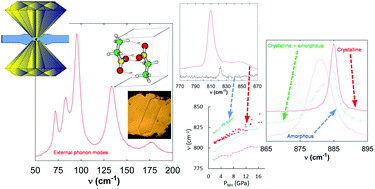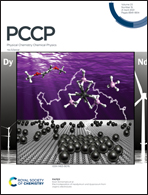Nitroethane at high density: an experimental and computational vibrational study†
Abstract
The vibrational spectrum of liquid and solid nitroethane was measured as a function of pressure. Both Raman scattering and absorption IR spectroscopies were applied to samples of nitroethane, statically compressed at ambient temperature to a maximum pressure of 8.0 GPa and 16.9 GPa, respectively. A new amorphous to crystalline transition pressure was found to lie between 1.59–1.63 GPa. Davydov splitting of internal modes into two components suggests two molecules associated with the unit cell, which is consistent with the DFT predictions made in a previous study. For most bands below 1200 cm−1, pressure induced mode progression was consistent with DFT predictions. Conversely, observed mode shifts in the 2950–3100 cm−1 region were generally stiffer than their DFT counterparts. A discontinuity in mode evolution between 3.7–4.3 GPa was observed for a number of modes and shown to coincide with hydrogen bond rearrangement in this pressure region. Preferred orientation and crystallite strain might explain the increased scatter between the various pressure induced mode shift cycles. Time intervals on the order of ∼30 h may be required between spectra, in order to give the crystallites time to equilibrate their strain.



 Please wait while we load your content...
Please wait while we load your content...